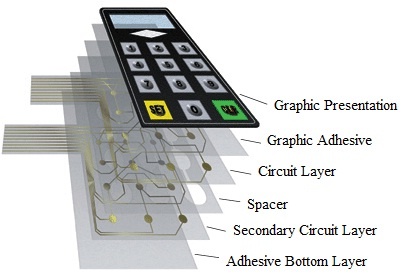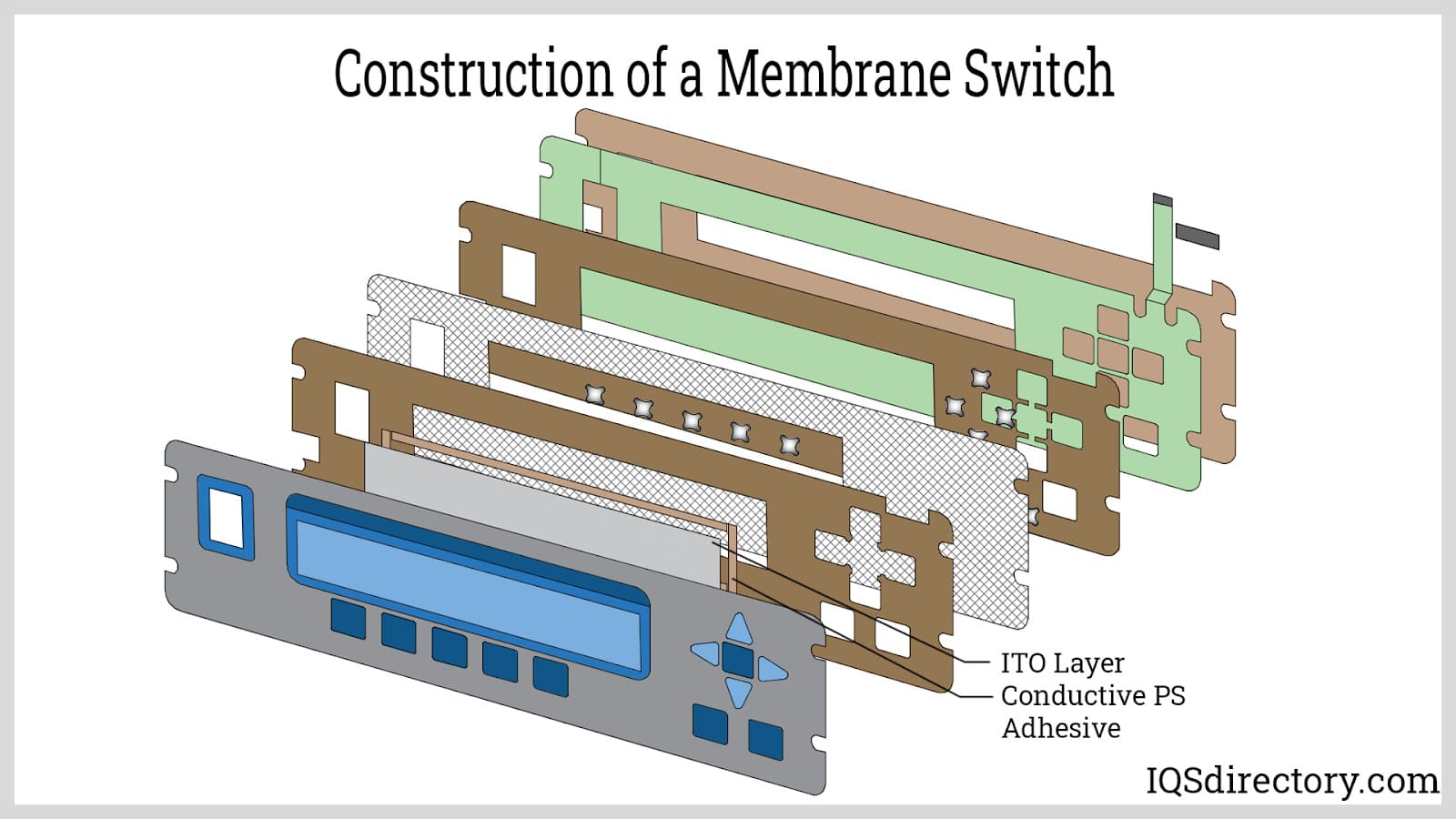The Production Process Behind Membrane Switch: What You Required to Know
The manufacturing procedure behind membrane changes combines cautious design, product choice, and quality assurance. It begins with recognizing the complexities of membrane button layout and advances via various phases, consisting of product selections and printing methods. Each phase plays a vital function in making certain functionality and resilience. Nonetheless, the intricacies of layer construction and the extensive screening standards might reveal insights that are not promptly obvious. What exists beyond these fundamental elements?
Recognizing Membrane Switch Over Style
Membrane buttons may show up easy at initial look, their design entails intricate considerations that ensure capability and longevity. The style procedure begins with an extensive understanding of customer demands, including the user interface's intended application and ecological factors. Functional designs is a crucial aspect, as the format has to facilitate simplicity of use while making certain that responsive feedback satisfies user expectations.Moreover, the layering of elements, such as graphic overlays, adhesive layers, and conductive traces, must be precisely crafted. membrane switch. This layered configuration not only influences the switch's responsiveness yet likewise influences its durability. Focus is provided to the securing strategies utilized to secure versus moisture and dust, which could compromise efficiency. In addition, style considerations reach looks, where color design and aesthetic clearness improve individual experience. Ultimately, the layout of membrane layer changes equilibriums performance, individual experience, and toughness, making sure that they meet the needs of various applications efficiently
Materials Made Use Of in Membrane Layer Switch Manufacturing
When selecting products for membrane switch production, it is important to ponder both performance and sturdiness. The main materials consist of polyester and polycarbonate movies, which provide versatility and toughness. These movies are usually coated with glue to assure appropriate bonding to substratums. Conductive inks, typically made up of silver or carbon, are critical for developing electric connections within the switch, enabling trustworthy operation.Additionally, a protective layer, such as a hard layer, is frequently applied to improve scrape resistance and longevity. The selection of backing material, such as acrylic or foam, can substantially influence the button's tactile feeling and total user experience. Furthermore, various ecological variables, consisting of temperature level and moisture, ought to lead product choice to assure peak performance in particular applications. Ultimately, the ideal combination of materials adds to the membrane button's functionality and life expectancy, making informed choices important for makers.
The Printing Process: Creating Video and Text
The printing process in membrane layer button manufacturing plays a substantial duty in generating top notch graphics and text. Various visuals layout strategies are used to guarantee visual charm and capability, while careful ink choice methods are necessary for resilience and efficiency. Comprehending these components is essential for accomplishing ideal results in membrane switch layout.
Graphic Style Techniques
Graphic style methods play an essential function in the printing process of membrane layer buttons, as they specify how graphics and message will inevitably appear on the end product. Efficient graphic style entails the critical usage of designs, font styles, and colors to boost readability and visual charm. Designers typically utilize vector graphics for scalability, guaranteeing that images remain sharp at numerous dimensions. Furthermore, interest to contrast and placement is essential, as it influences customer communication and aesthetic top quality. The incorporation of branding elements, such as logos, must be managed with care to preserve brand stability. Overall, thoughtful visuals design methods add substantially to the performance and attractiveness of membrane switches, influencing customer experience and item performance.
Ink Choice Approaches
Selecting the ideal ink is vital for attaining the wanted aesthetic top quality and sturdiness in membrane layer switch production. Various ink kinds are made use of, including solvent-based, water-based, and UV-curable inks. Each kind offers unique characteristics, such as flexibility, resistance, and bond to environmental factors. Solvent-based inks are typically preferred for their durability and dynamic colors, while water-based inks are more eco-friendly however may have constraints in bond. UV-curable inks provide fast healing and robust efficiency. Additionally, color matching techniques guarantee that the picked inks straighten with layout requirements. Eventually, the option of ink have to think about factors such as application approach, substratum compatibility, and end-use needs to accomplish premium cause membrane layer button graphics and message.
Layer Building and Assembly

Product Option Process
A careful option of products is necessary in the manufacturing process of membrane switches, as it directly influences capability and toughness. The primary products utilized include polyester, polycarbonate, and different conductive inks. Polyester is usually preferred for its excellent resistance to chemicals and abrasion, making it suitable for extreme environments. Polycarbonate, on the other hand, gives exceptional quality and effect resistance, which is useful for applications calling for exposure and toughness. Conductive inks, usually composed of silver or carbon, are his response crucial for developing trustworthy electric paths. Additionally, the choice of glue materials impacts the general honesty of the switch - membrane switch. Examining factors such as ecological exposure, tactile feedback, and aesthetic requirements overviews suppliers in selecting the very best products for their details applications
Layer Bond Strategies
Adhering layers in membrane switch construction is an important process that guarantees performance and long life. Numerous bond techniques are used to secure optimal bonding in between layers, which usually consist of using adhesives, heat, and pressure. Pressure-sensitive adhesives (PSAs) are typically used for their simplicity of application and immediate bonding capabilities. In addition, thermal bonding methods can be applied, where warmth is made use of to turn on sticky properties, securing a strong bond. The option of attachment technique mainly depends on the products included and the specific application demands of the membrane layer button. Correct positioning and consistent application of adhesives are vital to stop flaws, securing the button runs efficiently throughout its intended life-span.
Quality Assurance Actions
Ensuring quality assurance throughout the layer construction and assembly of membrane layer switches is vital for keeping performance and dependability. This procedure generally entails numerous crucial measures, including thorough inspections at each stage of production. Producers use advanced screening techniques, such as peel examinations and attachment evaluations, to confirm the honesty of layer bonds. In addition, aesthetic assessments are performed to determine any problems in printing or material incongruities. Ecological problems, such as temperature and humidity, are thoroughly monitored to ensure optimal treating and attachment. Normal calibration of devices assists maintain exact manufacturing criteria. By executing these quality assurance procedures, manufacturers can greatly decrease the threat of item failing, ensuring that the final membrane layer changes meet the required specs and consumer assumptions.
Testing and Quality Control Steps

Technologies in Membrane Layer Switch Over Innovation
As advancements in technology continue to evolve, find more membrane switches are gaining from ingenious developments that boost their capability and individual experience. One notable advancement is the integration of capacitive touch modern technology, which enables for even more instinctive and responsive interface. This change not just enhances looks however additionally minimizes mechanical damage, extending the lifespan of the switches.Additionally, improvements in visuals overlay materials have actually brought about boosted durability and resistance to environmental aspects such as dampness and UV light. These products currently provide boosted quality and brightness, more raising the aesthetic appeal.Furthermore, the incorporation of wise modern technology is transforming membrane changes into interactive control panels, enabling connection with IoT gadgets. This connection fosters a smooth customer experience, paving the way for applications in various sectors, from health care to customer electronics. Collectively, these advancements placement membrane layer switches over as vital components in modern-day tool design.
Frequently Asked Concerns
How much time Does the Membrane Switch Over Manufacturing Refine Take?
The period of the membrane switch production process can vary considerably. Variables such as intricacy, products utilized, and manufacturing volume influence timelines, with normal manufacturing varying from a few days to several weeks for conclusion.
What Are the Usual Applications for Membrane Buttons?
Membrane layer buttons are frequently utilized in different markets, consisting of automotive controls, household appliances, medical tools, and customer electronic devices (membrane switch). Their adaptability and sturdiness make them excellent for applications calling for user-friendly user interfaces and trustworthy performance in diverse environments
Can Membrane Changes Be Personalized for Specific Demands?

What Is the Life expectancy of a Regular Membrane Layer Switch Over?
The life expectancy of a typical membrane button differs, but normally, it ranges from 1 to 5 million cycles. Factors such as usage, atmosphere, and worldly top quality considerably affect sturdiness and overall efficiency with time.

Are Membrane Changes Eco-friendly?
The ecological kindness of membrane layer changes differs. Some materials made use of might not be recyclable, blog here while others can be environment-friendly. The total effect relies on making products and techniques, demanding careful factor to consider throughout selection and disposal. The production process behind membrane switches combines cautious design, material option, and high quality control. It begins with understanding the complexities of membrane layer button style and proceeds with different phases, consisting of material selections and printing strategies. When picking materials for membrane layer switch manufacturing, it is essential to consider both efficiency and longevity. A cautious option of materials is important in the production procedure of membrane buttons, as it straight affects capability and durability. The choice of bond method largely depends on the materials entailed and the details application requirements of the membrane layer switch.